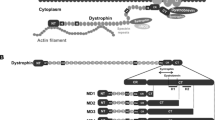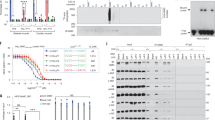Abstract
Potentially viable therapeutic approaches for Duchenne muscular dystrophy (DMD) are now within reach. Indeed, clinical trials are currently under way. Two crucial aspects still need to be addressed: maximizing therapeutic efficacy and identifying appropriate and sensible outcome measures. Nevertheless, the end point of these trials remains painful muscle biopsy to show and quantify protein restoration in treated boys. In this study we show that PMMA/N-isopropil-acrylamide+ (NIPAM) nanoparticles (ZM2) bind and convey antisense oligoribonucleotides (AONs) very efficiently. Systemic injection of the ZM2–AON complex restored dystrophin protein synthesis in both skeletal and cardiac muscles of mdx mice, allowing protein localization in up to 40% of muscle fibers. The mdx exon 23 skipping level was up to 20%, as measured by the RealTime assay, and dystrophin restoration was confirmed by both reverse transcription-PCR and western blotting. Furthermore, we verified that dystrophin restoration also occurs in the smooth muscle cells of the dorsal skin arrector pili, an easily accessible histological structure, in ZM2–AON-treated mdx mice, with respect to untreated animals. This finding reveals arrector pili smooth muscle to be an appealing biomarker candidate and a novel low-invasive treatment end point. Furthermore, this marker would also be suitable for subsequent monitoring of the therapeutic effects in DMD patients. In addition, we demonstrate herein the expression of other sarcolemma proteins such as α-, β-, γ- and δ-sarcoglycans in the human skin arrector pili smooth muscle, thereby showing the potential of this muscle as a biomarker for other muscular dystrophies currently or soon to be the object of clinical trials.
This is a preview of subscription content, access via your institution
Access options
Subscribe to this journal
Receive 12 print issues and online access
$259.00 per year
only $21.58 per issue
Buy this article
- Purchase on Springer Link
- Instant access to full article PDF
Prices may be subject to local taxes which are calculated during checkout




Similar content being viewed by others
References
Aartsma-Rus A, Van Deutekom JC, Fokkema IF, Van Ommen GJ, Den Dunnen JT . Entries in the Leiden Duchenne muscular dystrophy mutation database: an overview of mutation types and paradoxical cases that confirm the reading-frame rule. Muscle Nerve 2006; 34: 135–144.
Hamed SA . Drug evaluation: PTC-124—a potential treatment of cystic fibrosis and Duchenne muscular dystrophy. IDrugs 2006; 9: 783–789.
Aartsma-Rus A, van Ommen GJ . Antisense-mediated exon skipping: a versatile tool with therapeutic and research applications. RNA 2007; 13: 1609–1624 (Review).
Hoffman E . Skipping toward personalized molecular medicine. N Engl J Med 2007; 357: 2719–2722.
Du L, Gatti R . Progress toward therapy with antisense-mediated splicing modulation. Curr Opin Mol Ther 2009; 11: 116–123.
van Deutekom J, Janson AA, Ginjaar IB, Frankhuizen WS, Aartsma-Rus A, Bremmer-Bout M et al. Local dystrophin restoration with antisense oligonucleotide PRO 051. N Engl J Med 2007; 357: 2677–2686.
Lu Q, Rabinowitz A, Chen YC, Yokota T, Yin H, Alter J et al. Systemic delivery of antisense oligoribonucleotide restores dystrophin expression in body-wide skeletal muscles. Proc Natl Acad Sci USA 2005; 102: 198–203.
Alter J, Lou F, Rabinowitz A, Yin H, Rosenfeld J, Wilton SD et al. Systemic delivery of morpholino oligonucleotide restores dystrophin expression bodywide and improves dystrophic pathology. Nat Med 2006; 12: 175–177.
Heemskerk H, de Winter CL, de Kimpe SJ, van Kuik-Romeijn P, Heuvelmans N, Platenburg GJ et al. In vivo comparison of 2′-O-methyl phosphorothioate and morpholino antisense oligonucleotides for duchenne muscular dystrophy exon skipping. J Gene Med 2009; 11: 257–266.
Popplewell L, Trollet C, Dickson G, Graham IR . Design of phosphorodiamidate morpholino oligomers (PMOs) for the induction of exon skipping of the human DMD gene. Mol Ther 2009; 17: 554–561.
Rimessi P, Sabatelli P, Fabris M, Braghetta P, Bassi E, Spitali P et al. Cationic PMMA nanoparticles bind and deliver antisense oligoribonucleotides allowing restoration of dystrophin expression in the mdx mouse. Mol Ther 2009; 17: 820–827.
Malerba A, Thorogood FC, Dickson G, Graham IR . Dosing regimen has a significant impact on the efficiency )of morpholino oligomer-induced exon skipping in mdx mice. Hum Gene Ther 2009; 20: 955–965.
Marbini A, Gemignani F, Bellanova MF, Guidetti D, Ferrari A . Immunohistochemical localization of utrophin and other cytoskeletal proteins in skin smooth muscle in neuromuscular diseases. J Neurol Sci 1996; 143: 156–160.
Marbini A, Marcello N, Bellanova MF, Guidetti D, Ferrari A, Gemignani F . Dystrophin expression in skin biopsy immunohistochemical. Localisation of striated muscle type dystrophin. J Neurol Sci 1995; 129: 29–33.
Tanveer N, Sharma MC, Sarkar C, Gulati S, Kalra V, Singh S et al. Diagnostic utility of skin biopsy in dystrophinopathies. Clin Neurol Neurosurg 2009; 111: 496–502.
Gleason R, Dye WW, Wilson E, Humphrey JD . Quantification of the mechanical behavior of carotid arteries from wild-type, dystrophin-deficient, and sarcoglycan-delta knockout mice. J Biomech 2008; 41: 3213–3218.
Prentice R . Surrogate and mediating endpoints: current status and future directions. J Natl Cancer Inst 2009; 101: 216–217.
Mandrekar S, Sargent DJ . Clinical trial designs for predictive biomarker validation: one size does not fit all. J Biopharm Stat 2009; 19: 530–542.
McShane L, Hunsberger S, Adjei AA . Effective incorporation of biomarkers into phase II trials. Clin Cancer Res 2009; 15: 1898–1905.
Acknowledgements
The Telethon Italy grants GGP05115, GUP07011 and GGP09093 (to AF) are acknowledged. Thanks are also due to Prof A Medici (Department of Chemistry, University of Ferrara) to the Industria Chimica Emiliana (ICE Reggio Emilia) Grant (to AF), and to TREAT-NMD Network of Excellence of EU FP7 n. 036825 (to LM and Telethon-Italy). We are also grateful to the ISS National AIDS Program grants, in support of the Nanoparticle technology platform, awarded to AC, LT and ML. The ZM2–AON compound and its effects have been patented at the University of Ferrara, Industrial Liaison Office, patent IP number TO2009A000782.
Author information
Authors and Affiliations
Corresponding author
Additional information
Supplementary Information accompanies the paper on Gene Therapy website (http://www.nature.com/gt)
Rights and permissions
About this article
Cite this article
Ferlini, A., Sabatelli, P., Fabris, M. et al. Dystrophin restoration in skeletal, heart and skin arrector pili smooth muscle of mdx mice by ZM2 NP–AON complexes. Gene Ther 17, 432–438 (2010). https://doi.org/10.1038/gt.2009.145
Received:
Revised:
Accepted:
Published:
Issue Date:
DOI: https://doi.org/10.1038/gt.2009.145
Keywords
This article is cited by
-
Cell-Based and Gene-Based Therapy Approaches in Neuro-orthopedic Disorders: a Literature Review
Regenerative Engineering and Translational Medicine (2023)
-
Correlating In Vitro Splice Switching Activity With Systemic In Vivo Delivery Using Novel ZEN-modified Oligonucleotides
Molecular Therapy - Nucleic Acids (2014)
-
Progress in gene therapy of dystrophic heart disease
Gene Therapy (2012)
-
Preclinical PK and PD Studies on 2′-O-Methyl-phosphorothioate RNA Antisense Oligonucleotides in the mdx Mouse Model
Molecular Therapy (2010)



